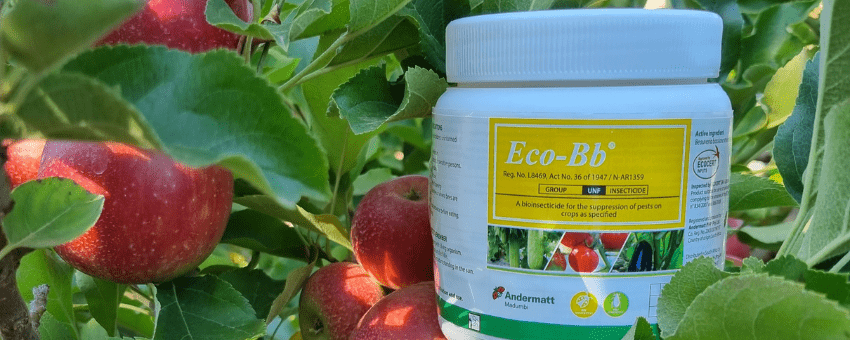Targeting Mealybug with Eco-Bb®
The recent approval and registration of Eco-Bb®, for the suppression of Mealybug on pome fruit (apples, pears), citrus and grapes has attracted much interest and attention from growers. Mealybugs are one of the most important pests of citrus and vines in South Africa but is also of economic importance in many other crops such as apples, pears, mangos, macadamia nuts, sweet peppers, blueberries and other vegetables and ornamentals.
Why use Eco-Bb® against Mealybug?
- Eco-Bb® can help break the Mealybug life cycle by targeting the crawler instar. The crawler stage is most susceptible to Eco-Bb®. Early applications are key to effective suppression
- Once adults are present, multiple applications will be required to target newly hatched crawlers (adults are not susceptible and therefore will continue to lay eggs). Be aware that once a colony is established, there will always be all life stages present.
- Eco-Bb® will not negatively affect beneficial insects such as Anagyrus spp. in fact, they should be complementary as Anagyrus will target the second and third instar as well as the adults, which are more difficult to target with Eco-Bb®, and Anagyrus does not target the crawlers.
- Eco-Bb® does not have MRL constraints and can be used up until harvest.
- Eco-Bb® is non-toxic and work can continue in the orchard immediately after spraying.
- Eco-Bb®has a unique and complex mode of action, as such it is an excellent resistance
management tool. - Contact is critical to efficacy. Area specific sprays are most effective.
For more information please visit www.andermatt.co.za or contact your regional biospecialist.


Healthy Mealybug colony with different life stages existing together. Note the woolly egg sack and white castings that can be confused with Eco-Bb® mycelium.

Mealybug crawler mycosed with Eco-Bb® viewed under a dissecting microscope. Note the much thinner strands of mycelium and densely packed mycelium compared with the woolly egg sack.
Teiken Witluis met Eco-Bb®
TDie onlangse goedkeuring en registrasie van Eco-Bb® vir die onderdrukking van witluis op kernvrugte (appels, pere), sitrus en druiwe het baie belangstelling en aandag van produsente gelok. Witluis is een van die belangrikste sitrus en wingerd plae in Suid-Afrika, maar is ook van ekonomiese belang in baie ander gewasse soos appels, pere, mango’s, makadamianeute, soetrissies, bloubessies en ander groente en sierplante.
Hoekom Eco-Bb® gebruik teen Witluis?
- Eco-Bb® kan help om die Witluis-lewensiklus te breek deur die kruiper instar te teiken. Die kruiperstadium is die vatbaarste vir Eco-Bb®. Vroeë toedienings is die sleutel tot effektiewe onderdrukking.
- Sodra volwassenes teenwoordig is, sal verskeie toedienings benodig word om nuut uitgebroeide kruipers te teiken. Volwassenes is nie vatbaar vir Eco-Bb® nie en sal dus voortgaan om eiers te lê. Wees bewus daarvan dat sodra ʼn populasie gevestig is, daar altyd alle lewensfases teenwoordig sal wees.
- Eco-Bb® sal nie voordelige insekte soos Anagyrus sp. negatief beïnvloed nie. Inteendeel, hulle sal aanvullend werk aangesien Anagyrus die tweede en derde instar sowel as die volwassenes sal teiken, wat moeiliker is om met Eco-Bb® te teiken, en Anagyrus teiken nie die kruipers nie.
- Eco-Bb® het nie MRL-beperkings nie en kan tot tydens oes gebruik word.
- Eco-Bb® ® is nie giftig en werk kan onmiddellik na bespuiting in die boord voortgaan.
- Eco-Bb® het ‘n unieke en komplekse manier van werking, as sodanig is dit ‘n uitstekende
weerstandsbestuursinstrument. - Kontak is van kritieke belang vir doeltreffendheid. Area spesifieke bespuitings is die doeltreffendste
Vir meer inligting besoek gerus www.andermatt.co.za of kontak u plaaslike biospesialis.


Gesonde Witluiskolonie met verskillende lewensfases wat saam leef. Let op die wollerige eiersak en wit vervelling wat verwar kan word met Eco-Bb® miselium.

Witluiskruiper dood weens Eco-Bb® swambesmetting gesien onder ‘n dissekteermikroskoop. Let op die baie fyner en diggepakte miselium in vergelyking met die wollerige eiersak bo.

